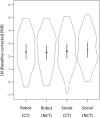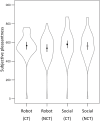Modulation of the post-auricular reflex in response to social and CT-optimal touch
- PMID: 40802700
- PMCID: PMC12349074
- DOI: 10.1371/journal.pone.0329625
Modulation of the post-auricular reflex in response to social and CT-optimal touch
Abstract
The pleasantness perception of CT-optimal touch is usually assessed with subjective and explicit measures. As these can be prone to biases, it is important to develop implicit measures as well. The vestigial post-auricular muscle reflex (PAR) might be a good candidate, given its sensitivity to pleasant visual and auditory stimuli. As such, we investigated if the PAR can also be modulated by CT-optimal touch. We additionally compared how the PAR responds to social and robotic touch and conducted control experiments to replicate the reflex's specific sensitivity to primary rewards. The sample consisted of 43 non-clinical participants. PAR responses were recorded while participants were touched by an experimenter and a robot, with a velocity of 3 cm/s (CT-optimal touch) and 18 cm/s (CT non-optimal touch). After each trial, participants also subjectively rated the pleasantness of the touch. Although the results revealed that CT-optimal touch was subjectively perceived to be more pleasant than CT non-optimal touch, it did not result in a potentiation of the PAR. Interestingly, social touch was subjectively perceived to be more pleasant than robotic touch and potentiated the PAR. The control experiments confirmed that the PAR is particularly modulated by primary (food, erotica), and not secondary (adventure, cuteness, monetary) rewards. While additional research is needed to further investigate the relation between the PAR and CT-optimal touch, the current results do already suggest that this reflex responds to the primary reward value of social touch.
Copyright: © 2025 Hasenack et al. This is an open access article distributed under the terms of the Creative Commons Attribution License, which permits unrestricted use, distribution, and reproduction in any medium, provided the original author and source are credited.
Conflict of interest statement
The authors have declared that no competing interests exist.
Figures





Similar articles
-
Prescription of Controlled Substances: Benefits and Risks.2025 Jul 6. In: StatPearls [Internet]. Treasure Island (FL): StatPearls Publishing; 2025 Jan–. 2025 Jul 6. In: StatPearls [Internet]. Treasure Island (FL): StatPearls Publishing; 2025 Jan–. PMID: 30726003 Free Books & Documents.
-
Sexual Harassment and Prevention Training.2024 Mar 29. In: StatPearls [Internet]. Treasure Island (FL): StatPearls Publishing; 2025 Jan–. 2024 Mar 29. In: StatPearls [Internet]. Treasure Island (FL): StatPearls Publishing; 2025 Jan–. PMID: 36508513 Free Books & Documents.
-
The Effect of Labeling During Simulated Contact on Attitudes Toward Autistic Adults.Autism Adulthood. 2025 Feb 5;7(1):93-99. doi: 10.1089/aut.2023.0081. eCollection 2025 Feb. Autism Adulthood. 2025. PMID: 40151654
-
The Black Book of Psychotropic Dosing and Monitoring.Psychopharmacol Bull. 2024 Jul 8;54(3):8-59. Psychopharmacol Bull. 2024. PMID: 38993656 Free PMC article. Review.
-
Incentives for preventing smoking in children and adolescents.Cochrane Database Syst Rev. 2017 Jun 6;6(6):CD008645. doi: 10.1002/14651858.CD008645.pub3. Cochrane Database Syst Rev. 2017. PMID: 28585288 Free PMC article.
References
-
- Kidd T, Devine SL, Walker SC. Affective touch and regulation of stress. 2023. Responses. Health Psychol Rev. 2023;17(1):60–77. - PubMed
MeSH terms
LinkOut - more resources
Full Text Sources
Research Materials

